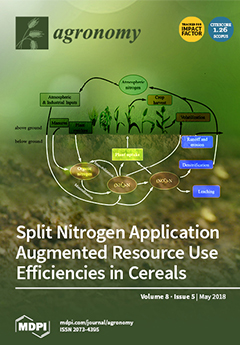In rainfed agricultural ecosystems in northwest China, improving soil fertility and reducing greenhouse gas (GHG) emissions are key factors for developing sustainable agriculture. This study determined the short-term effects of different biochar amendment rates on diurnal and seasonal variations of GHG emissions in the Loess Plateau to produce a background dataset that may be used to inform nutrient management guidelines for semiarid environments. Biochar produced by pyrolysis at 300–500 °C from maize straw was applied at rates of 0, 10, 20, 30, 40, and 50 t ha
−1 (T0, T1, T2, T3, T4, T5), respectively. The results indicated that in the first year after the application, T3, T4, and T5 treatments increased soil organic carbon (0–10 cm) by 54.7%, 56.3%, and 56.9% compared to the other treatments. In the first, year, biochar amendment decreased diurnal CH
4 and N
2O flux by an average of 17–119% compared to T0, among which T3 had the lowest mean value. T3 and T4 also had similar mean CO
2 flux, which was 33% lower than T0. Application of 30 t ha
−1 biochar produced the lowest cumulative CO
2 and N
2O emissions of 2300 and 4.07 kg h
−1, respectively. Biochar amendment showed no effect on grain yiel but reduced the global warming potential and GHG emission intensity by an average of 23% and 25%, respectively. The biochar application rate of 30 t ha
−1 under the conditions of this study may be an appropriate rate for improving soil C sequestration and mitigation of GHG emissions in the first year after its application to soils on semi–arid Loess Plateau.
Full article





